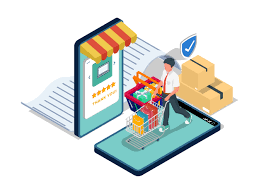Marketplaces have unquestionably ruled the world of e-commerce over the last decade, and they only appear to be getting stronger. Customers rush to global businesses like Amazon, Farfetch, Asos, and eBay to take advantage of a variety.
These companies have gone even further to ensure that their products are available to audiences all over the world. Instead of being an impediment, this allows them to not only establish their brands locally but also to simplify and monetize distribution.
According to 2018, Pitney Bowes Global Ecommerce Study, 68 percent of online buyers prefer purchasing from a marketplace across an individual online brand shop because of the variety of brands offered on these platforms. So, let’s take a deeper look at the major reasons why “the world loves an eCommerce marketplace platform with different locations.”
Allows for a more convenient and straightforward shopping experience:
By having global stores available online, shoppers will be less confused than they would be on a traditional website, making it easier to make swift purchasing selections.
Localization of stores:
Customers can expect personalization in payment, shipping rates, selling prices, store currency, nation taxes, content translations, and more in 2021. Brands can establish a strong relationship with international customers by opening local outlets.
Partnerships that can trusted:
When it comes to online transactions, a huge majority of consumers still find it difficult to trust an e-tailer. Almost all online marketplaces today handle this problem by providing cash-on-delivery payment options as well as simple return procedures.
Furthermore, marketplaces allow consumers to shop directly from established businesses.
These are frequently indicated with positive public ratings and genuine reviews; the portal’s own identification tags to verify the quality of the product and/or delivery service.
For example, the label ‘Fulfilled by Amazon’ signifies that Amazon handles product inventory and dispatch, whereas the label ‘Flipkart Assured’ is reserved for vendors that offer high-quality goods. Buyers are more comfortable trying goods from a vendor for the first time. ultimately trusting the brand for recurrent purchases because of the relationship that marketplaces have built with trustworthy vendors.
Quality and cost-effectiveness:
The marketplace model’s exceptional reach to a larger audience base has resulted in increasing competition for merchants. Several worldwide and domestic brands are competing for customers by offering low prices, high-quality products or services, and unique offers like deals or discounts.
As a result, customers may search a wide range of possibilities on a single platform and choose what attracts them the most at a reasonable price. Additionally, numerous marketplaces provide regular users with additional loyalty points, allowing consumers to acquire products that meet worldwide quality requirements while still saving money.
Discounts & Offers That Are Unique to You:
Customers currently expect personalization in practically everything, but especially in deals and promotions that are both intriguing to them and reflect their purchasing habits. They give clients the impression that they will cater to them throughout the “selling” process. Sending out a coupon on a customer’s birthday or anniversary of joining up to one’s site is a great example.
What makes eCommerce Marketplaces unique?
Aids in the growth of sales
eCommerce marketplace websites, attract sellers because they provide them with access to a large customer base. Customers are more likely to come upon things they didn’t want to buy while browsing products on marketplaces.
As a result, when a broad selection of products from various vendors shown to people to pick from, possibilities of sales increase.
A significant number of customers are available
When sellers sell products that cater to a wide range of customer needs such as an eCommerce market; their specialized client section is instantly transferred to the new website.
As a result, buyers who are seeking vastly different things brought together on one platform. This is an additional feather in marketplaces’ cap because vendors gain access to a big number of clients on a single platform which may or may not be searching for the catalog they cater to, but who may become future buyers.
There’s no need to stock up on supplies
The fact that eCommerce marketplaces reduce the need to stock up on inventory is one of the most significant benefits. Vendors have had a lot of problems stocking up on merchandise. Keeping either too little or too much-stored items was seen as a drawback. The problem has finally been rectified thanks to markets. If perishable items, FMCG, or electronics are not sold out in a timely manner, their value diminishes.
Improved patterns of growth
Online marketplaces have shown exponential growth in the past and have the potential to do so again in the future. One of the main reasons is that they actively support transactions rather than participating in them. This gives them the freedom to not have to expand their employees as quickly as their firm grows.
They don’t need personnel to deal with the nitty-gritty of order processing and delivery; instead, they need them to maintain the platform so that it can handle the increasing volume of transactions. As a result, online marketplaces have had the potential to grow far quicker than traditional stores.
Final Words –
Marketplaces are safe places for performing buying and selling activities that offer not just security but top-notch shopping experience also. Marketplaces are still in their nascent stages and have the potential to deliver matchless experiences.
eCommerce marketplace platform has recognized the possibilities that this fundamental need of today’s consumer has. Many companies have taken advantage of this opportunity and are now experimenting with different strategies to keep their users interested.
Established domestic marketplaces like Ola, and more are gradually mastering the intricacies of technology, such as customer data analytics and Intelligence user interfaces; to provide better and more personalized buying experiences.

